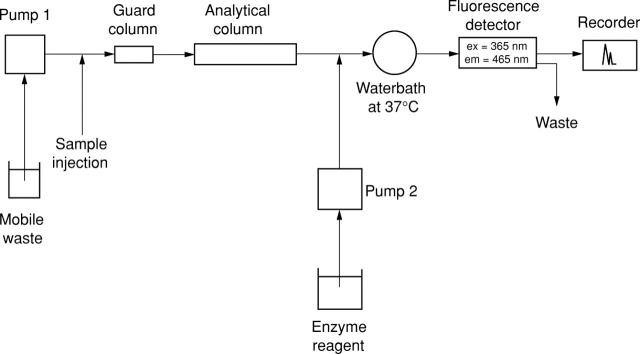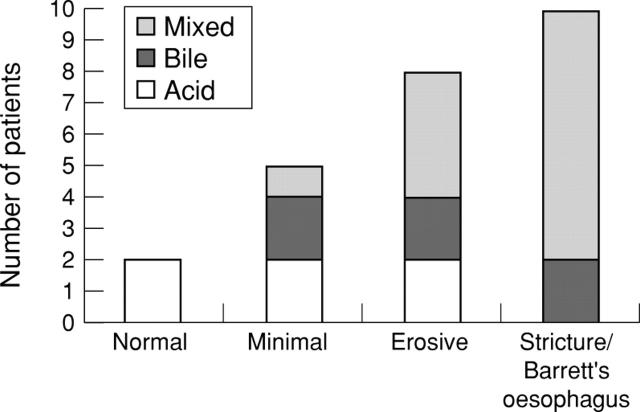Abstract
BACKGROUND—Bile acid toxicity has been shown in the gastric, colonic, and hepatic tissues; the effect on oesophageal mucosa is less well known. AIMS—To determine the spectrum of bile acids refluxing in patients with gastro-oesophageal reflux disease and its relation to oesophageal pH using a new technique of combined oesophageal aspiration and pH monitoring. METHODS—Ten asymptomatic subjects and 30 patients with symptoms of gastro-oesophageal reflux disease (minimal mucosal injury, erosive oesophagitis (grade 2 or 3 Savary-Miller), Barrett's oesophagus/stricture; n=10 in each group) underwent 15 hour continuous oesophageal aspiration with simultaneous pH monitoring. Bile acid assay of the oesophageal samples was performed using modified high performance liquid chromatography. RESULTS—The peak bile acid concentration and DeMeester acid scores were significantly higher in the patients with oesophagitis (median bile acid concentration 124 µmol/l; acid score 20.2) and Barrett's oesophagus/stricture (181 µmol/l; 43.3) than patients with minimal injury (14 µmol/l; 12.5) or controls (0 µmol/l; 11.1). The predominant bile acids detected were cholic, taurocholic, and glycocholic acids but there was a significantly greater proportion of secondary bile acids, deoxycholic and taurodeoxycholic acids, in patients with erosive oesophagitis and Barrett's oesophagus/stricture. Although bile acid reflux episodes occurred at variable pH, a temporal relation existed between reflux of taurine conjugates and oesophageal acid exposure (r=0.58, p=0.009). CONCLUSION—Toxic secondary bile acid fractions have been detected in patients with extensive mucosal damage. Mixed reflux is more harmful than acid reflux alone with possible toxic synergism existing between the taurine conjugates and acid.
Keywords: bile acids; reflux oesophagitis; Barrett's oesophagus
Full Text
The Full Text of this article is available as a PDF (120.6 KB).
Figure 1 .
Flow diagram of the modified HPLC method of bile acid assay, combining an enzymatic postcolumn derivation step.
Figure 2 .
Distribution of conjugated and unconjugated bile acids in each group. Interquartile range and medians are represented. *p<0.05 versus normal; †p<0.05 versus normal and minimal (Mann-Whitney U test).
Figure 3 .
Prevalence of the reflux pattern in each group categorised as acid refluxers, bile acid refluxers, and mixed bile acid and acid refluxers.
Selected References
These references are in PubMed. This may not be the complete list of references from this article.
- Armstrong D., Rytina E. R., Murphy G. M., Dowling R. H. Gastric mucosal toxicity of duodenal juice constituents in the rat. Acute studies using ex vivo rat gastric chamber model. Dig Dis Sci. 1994 Feb;39(2):327–339. doi: 10.1007/BF02090205. [DOI] [PubMed] [Google Scholar]
- Attwood S. E., Ball C. S., Barlow A. P., Jenkinson L., Norris T. L., Watson A. Role of intragastric and intraoesophageal alkalinisation in the genesis of complications in Barrett's columnar lined lower oesophagus. Gut. 1993 Jan;34(1):11–15. doi: 10.1136/gut.34.1.11. [DOI] [PMC free article] [PubMed] [Google Scholar]
- Batzri S., Harmon J. W., Schweitzer E. J., Toles R. Bile acid accumulation in gastric mucosal cells. Proc Soc Exp Biol Med. 1991 Sep;197(4):393–399. doi: 10.3181/00379727-197-43272. [DOI] [PubMed] [Google Scholar]
- Black R. B., Hole D., Rhodes J. Bile damage to the gastric mucosal barrier: the influence of pH and bile acid concentration. Gastroenterology. 1971 Aug;61(2):178–184. [PubMed] [Google Scholar]
- Caldwell M. T., Byrne P. J., Brazil N., Crowley V., Attwood S. E., Walsh T. N., Hennessy T. P. An ambulatory bile reflux monitoring system: an in vitro appraisal. Physiol Meas. 1994 Feb;15(1):57–65. doi: 10.1088/0967-3334/15/1/005. [DOI] [PubMed] [Google Scholar]
- Clark M. L., Lanz H. C., Senior J. R. Bile salt regulation of fatty acid absorption and esterification in rat everted jejunal sacs in vitro and into thoracic duct lymph in vivo. J Clin Invest. 1969 Sep;48(9):1587–1599. doi: 10.1172/JCI106124. [DOI] [PMC free article] [PubMed] [Google Scholar]
- Domellöf L., Reddy B. S., Weisburger J. H. Microflora and deconjugation of bile acids in alkaline reflux after partial gastrectomy. Am J Surg. 1980 Aug;140(2):291–295. doi: 10.1016/0002-9610(80)90024-0. [DOI] [PubMed] [Google Scholar]
- Gadacz T. R., Zuidema G. D. Bile acid composition in patients with and without symptoms of postoperative refulx gastritis. Am J Surg. 1978 Jan;135(1):48–52. doi: 10.1016/0002-9610(78)90008-9. [DOI] [PubMed] [Google Scholar]
- Gillen P., Keeling P., Byrne P. J., Healy M., O'Moore R. R., Hennessy T. P. Implication of duodenogastric reflux in the pathogenesis of Barrett's oesophagus. Br J Surg. 1988 Jun;75(6):540–543. doi: 10.1002/bjs.1800750612. [DOI] [PubMed] [Google Scholar]
- Goldstein J. L., Schlesinger P. K., Mozwecz H. L., Layden T. J. Esophageal mucosal resistance. A factor in esophagitis. Gastroenterol Clin North Am. 1990 Sep;19(3):565–586. [PubMed] [Google Scholar]
- Gotley D. C., Morgan A. P., Cooper M. J. Bile acid concentrations in the refluxate of patients with reflux oesophagitis. Br J Surg. 1988 Jun;75(6):587–590. doi: 10.1002/bjs.1800750632. [DOI] [PubMed] [Google Scholar]
- Holt P. R. Competitive inhibition of intestinal bile salt absorption in the rat. Am J Physiol. 1966 Mar;210(3):635–639. doi: 10.1152/ajplegacy.1966.210.3.635. [DOI] [PubMed] [Google Scholar]
- Hopwood D., Bateson M. C., Milne G., Bouchier I. A. Effects of bile acids and hydrogen ion on the fine structure of oesophageal epithelium. Gut. 1981 Apr;22(4):306–311. doi: 10.1136/gut.22.4.306. [DOI] [PMC free article] [PubMed] [Google Scholar]
- Iftikhar S. Y., Ledingham S., Steele R. J., Evans D. F., Lendrum K., Atkinson M., Hardcastle J. D. Bile reflux in columnar-lined Barrett's oesophagus. Ann R Coll Surg Engl. 1993 Nov;75(6):411–416. [PMC free article] [PubMed] [Google Scholar]
- Johnsson F., Joelsson B., Florén C. H., Nilsson A. Bile salts in the esophagus of patients with esophagitis. Scand J Gastroenterol. 1988 Aug;23(6):712–716. doi: 10.3109/00365528809093938. [DOI] [PubMed] [Google Scholar]
- Karmeli Y., Stalnikowitz R., Eliakim R., Rahav G. Conventional dose of omeprazole alters gastric flora. Dig Dis Sci. 1995 Sep;40(9):2070–2073. doi: 10.1007/BF02208680. [DOI] [PubMed] [Google Scholar]
- Kivilaakso E., Fromm D., Silen W. Effect of bile salts and related compounds on isolated esophageal mucosa. Surgery. 1980 Mar;87(3):280–285. [PubMed] [Google Scholar]
- Lillemoe K. D., Johnson L. F., Harmon J. W. Alkaline esophagitis: a comparison of the ability of components of gastroduodenal contents to injure the rabbit esophagus. Gastroenterology. 1983 Sep;85(3):621–628. [PubMed] [Google Scholar]
- Lillemoe K. D., Johnson L. F., Harmon J. W. Role of the components of the gastroduodenal contents in experimental acid esophagitis. Surgery. 1982 Aug;92(2):276–284. [PubMed] [Google Scholar]
- Matikainen M., Laatikainen T., Kalima T., Kivilaakso E. Bile acid composition and esophagitis after total gastrectomy. Am J Surg. 1982 Feb;143(2):196–198. doi: 10.1016/0002-9610(82)90066-6. [DOI] [PubMed] [Google Scholar]
- Mattioli S., Pilotti V., Felice V., Lazzari A., Zannoli R., Bacchi M. L., Loria P., Tripodi A., Gozzetti G. Ambulatory 24-hr pH monitoring of esophagus, fundus, and antrum. A new technique for simultaneous study of gastroesophageal and duodenogastric reflux. Dig Dis Sci. 1990 Aug;35(8):929–938. doi: 10.1007/BF01537239. [DOI] [PubMed] [Google Scholar]
- McKenzie D., Grayson T., Polk H. C., Jr The impact of omeprazole and laparoscopy upon hiatal hernia and reflux esophagitis. J Am Coll Surg. 1996 Oct;183(4):413–418. [PubMed] [Google Scholar]
- Nehra D., Howell P., Pye J. K., Beynon J. Assessment of combined bile acid and pH profiles using an automated sampling device in gastro-oesophageal reflux disease. Br J Surg. 1998 Jan;85(1):134–137. doi: 10.1046/j.1365-2168.1998.00533.x. [DOI] [PubMed] [Google Scholar]
- Nehra D., Watt P., Pye J. K., Beynon J. Automated oesophageal reflux sampler--a new device used to monitor bile acid reflux in patients with gastro-oesophageal reflux disease. J Med Eng Technol. 1997 Jan-Feb;21(1):1–9. doi: 10.3109/03091909709030296. [DOI] [PubMed] [Google Scholar]
- Poxon V. A., Morris D. L., Youngs D. J., Albutt E. C., Keighley M. R. Exposure to bile acids and bacteria over 24 hours following partial gastrectomy, vagotomy, and pyloroplasty. World J Surg. 1986 Dec;10(6):981–989. doi: 10.1007/BF01658652. [DOI] [PubMed] [Google Scholar]
- Rosser B. G., Gores G. J. Liver cell necrosis: cellular mechanisms and clinical implications. Gastroenterology. 1995 Jan;108(1):252–275. doi: 10.1016/0016-5085(95)90032-2. [DOI] [PubMed] [Google Scholar]
- Safaie-Shirazi S. Effect of pepsin on ionic permeability of canine esophageal mucosa. J Surg Res. 1977 Jan;22(1):5–8. doi: 10.1016/0022-4804(77)90117-2. [DOI] [PubMed] [Google Scholar]
- Salo J. A., Kivilaakso E. Contribution of trypsin and cholate to the pathogenesis of experimental alkaline reflux esophagitis. Scand J Gastroenterol. 1984 Oct;19(7):875–881. [PubMed] [Google Scholar]
- Schölmerich J., Becher M. S., Schmidt K., Schubert R., Kremer B., Feldhaus S., Gerok W. Influence of hydroxylation and conjugation of bile salts on their membrane-damaging properties--studies on isolated hepatocytes and lipid membrane vesicles. Hepatology. 1984 Jul-Aug;4(4):661–666. doi: 10.1002/hep.1840040416. [DOI] [PubMed] [Google Scholar]
- Stein H. J., Feussner H., Kauer W., DeMeester T. R., Siewert J. R. Alkaline gastroesophageal reflux: assessment by ambulatory esophageal aspiration and pH monitoring. Am J Surg. 1994 Jan;167(1):163–168. doi: 10.1016/0002-9610(94)90068-x. [DOI] [PubMed] [Google Scholar]
- Thorens J., Froehlich F., Schwizer W., Saraga E., Bille J., Gyr K., Duroux P., Nicolet M., Pignatelli B., Blum A. L. Bacterial overgrowth during treatment with omeprazole compared with cimetidine: a prospective randomised double blind study. Gut. 1996 Jul;39(1):54–59. doi: 10.1136/gut.39.1.54. [DOI] [PMC free article] [PubMed] [Google Scholar]
- Turjman N., Nair P. P. Nature of tissue-bound lithocholic acid and its implications in the role of bile acids in carcinogenesis. Cancer Res. 1981 Sep;41(9 Pt 2):3761–3763. [PubMed] [Google Scholar]





